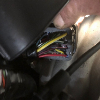2000StreetRod
Moderator Emeritus
- Joined
- May 26, 2009
- Messages
- 10,597
- Reaction score
- 334
- City, State
- Greenville, SC
- Year, Model & Trim Level
- 00 Sport FI, 03 Ltd V8
My 1991 copy of "Bosch Fuel Injection & Engine Management" shows on a graph that maximum power occurs when lambda is 0.86 (A/F=12.6:1) and minimum fuel consumption occurs when lambda is 1.05 (A/F=15.4:1). Most of the O2 sensor plots I've seen on this forum show a normal fluctuation between 0.1 volts (lambda = 1.02) and 0.9 volts (lambda = 0.98) with a mean of 0.5 volts (lambda = 1.005). This means that best fuel economy is being slightly sacrificed [(1.05-1.005)/1.05 = 4.3%] to reduce NOx emissions which is greatest at lambda = 1.03. This is because three-way catalytic converters are only effective in suppressing NOx emissions when lambda is less than or equal to 1.0.
Has anyone used a custom tune that leans the mixture to lambda = 1.05 resulting in a mean O2 sensor voltage of less than 0.1 volts? If so, how did it affect mpg?
Has anyone used a custom tune that leans the mixture to lambda = 1.05 resulting in a mean O2 sensor voltage of less than 0.1 volts? If so, how did it affect mpg?










